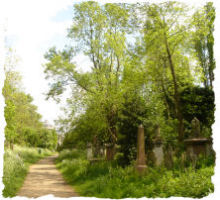
Arboretum and Garden Cemeteries
![]() emeteries were also promoted as public gardens and arboretums by landscape gardeners such as Loudon taking up suggestions from George Carden, John Strang in his Necropolis Glasuensis (1831) and others who saw them as an answer to the problems of modern urban society.
emeteries were also promoted as public gardens and arboretums by landscape gardeners such as Loudon taking up suggestions from George Carden, John Strang in his Necropolis Glasuensis (1831) and others who saw them as an answer to the problems of modern urban society.
Much of the inspiration came from Mount Auburn garden cemetery near Boston in the U.S.A. and the Père-Lachaise cemetery in Paris which was visited by many English tourists and literary travelers during the Peace of Amiens and after 1815. The extensive Mount Auburn site featured botanical gardens promoted by the American Horticultural Society.
In the Gardener’s Magazine and his treatise on laying out cemeteries, Loudon argued that they ought to be located on the urban periphery away from population centres and formally laid out with carefully tended tombs laid out in grids and planted with trees and labeled shrubs.
The cemetery would therefore serve as a ‘school of instruction in architecture, sculpture, landscape gardening, arboriculture, botany and the important points of general gardening: neatness order and high keeping’ ideally managed by municipal societies rather than private companies.
Loudon was commissioned to design cemeteries on these principles at Southampton, Cambridge and Bath Abbey and asked to advise on similar projects. The suggestions by Loudon and others were taken up and arboretum or garden cemeteries appeared in other towns.
George Loddiges laid out Abney Park Cemetery as an arboretum in London which opened in 1840, an event described approvingly in the Gardener’s Magazine and Loudon’s treatise in 1843. Garden and arboretum cemeteries satisfied the utilitarian concerns of public reformers whilst appealing to the pious Victorian aesthetics of death.
